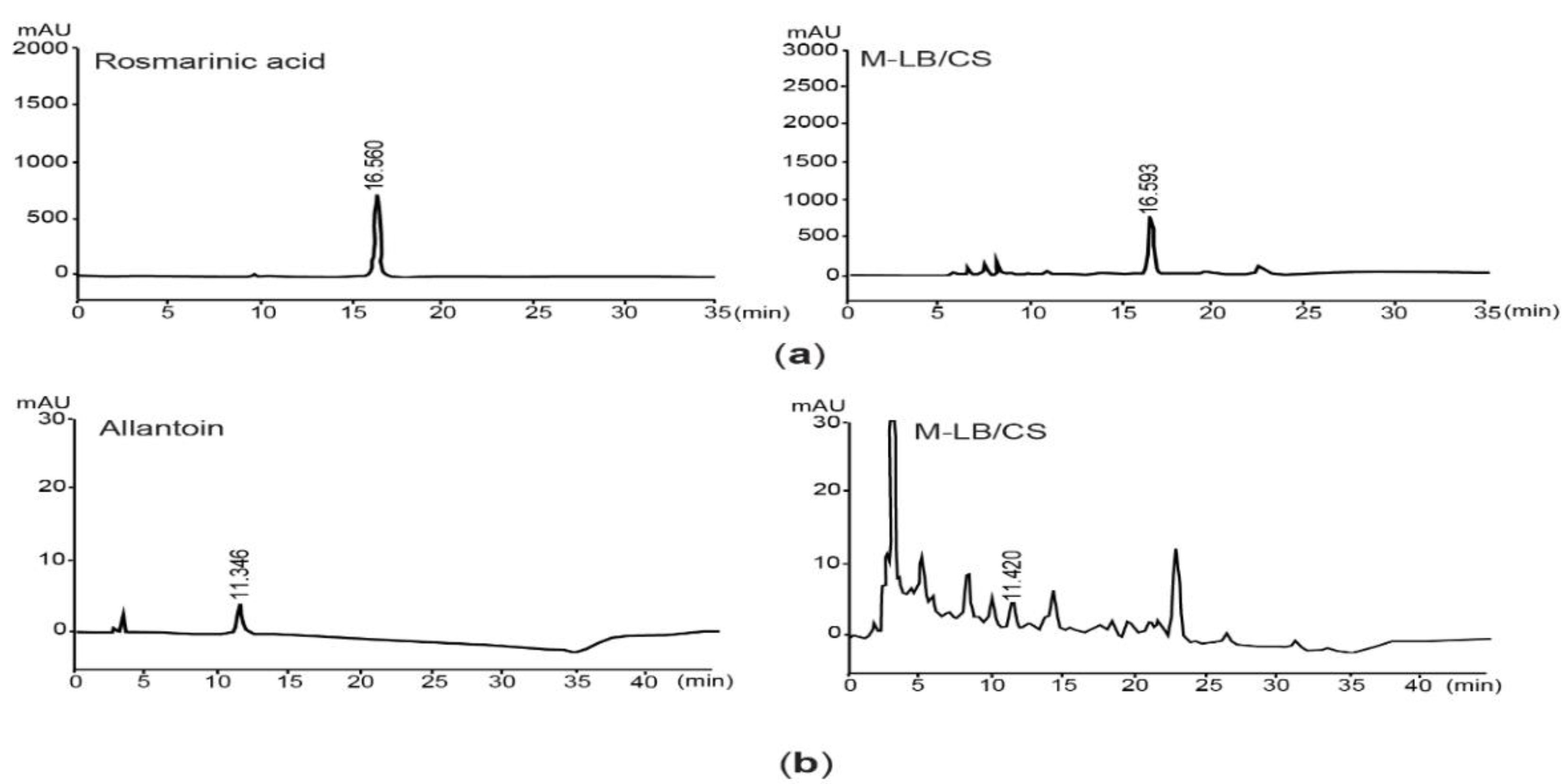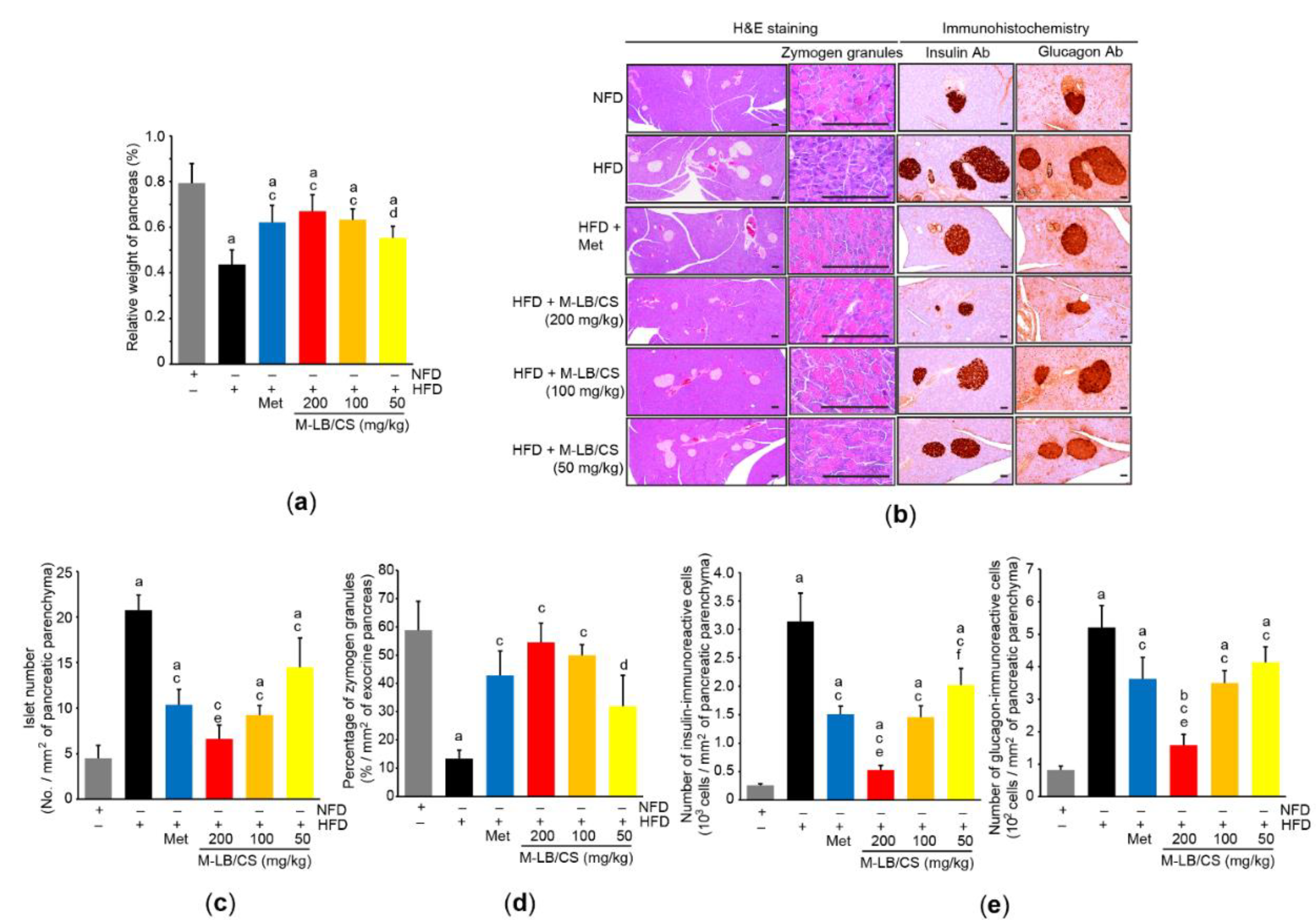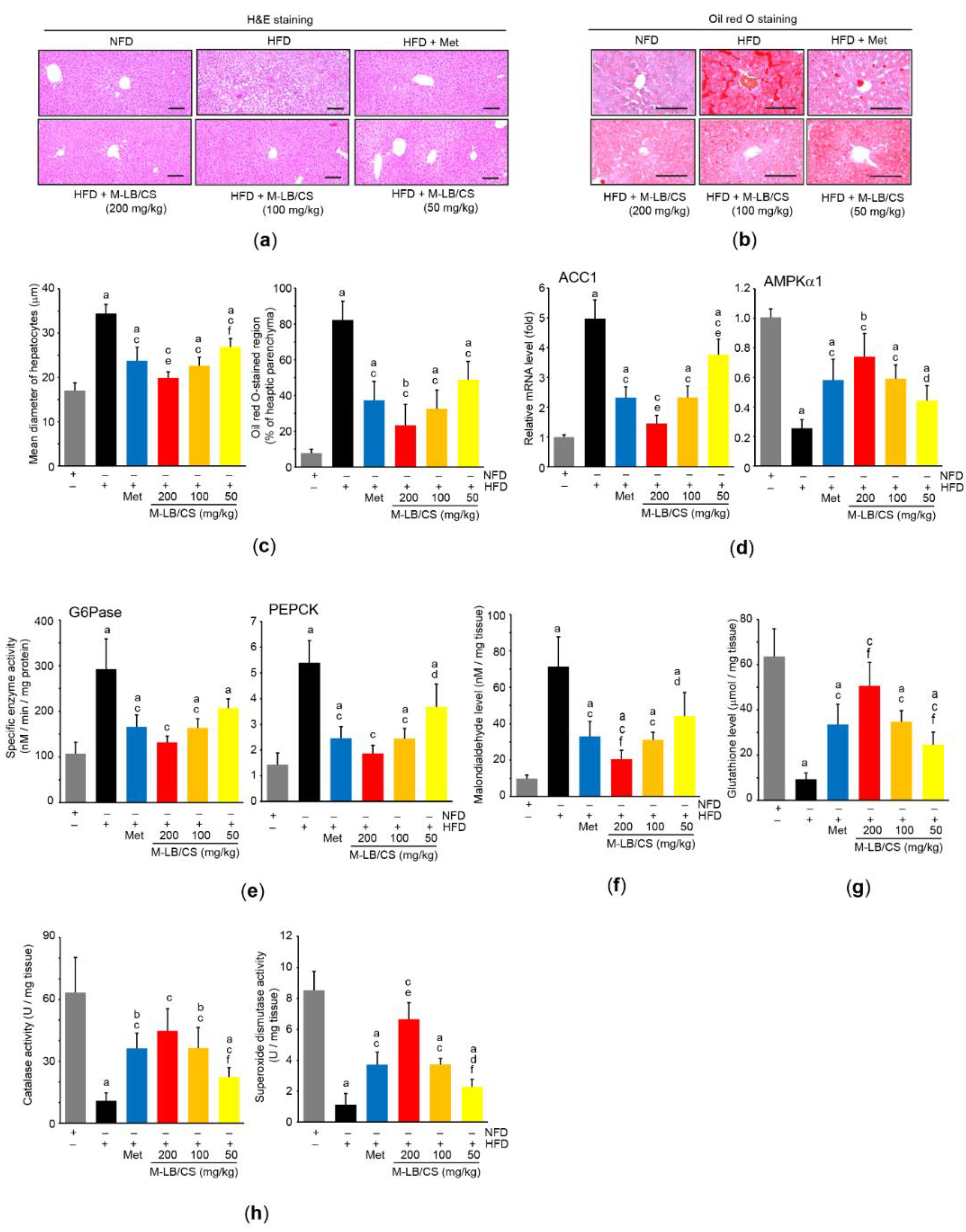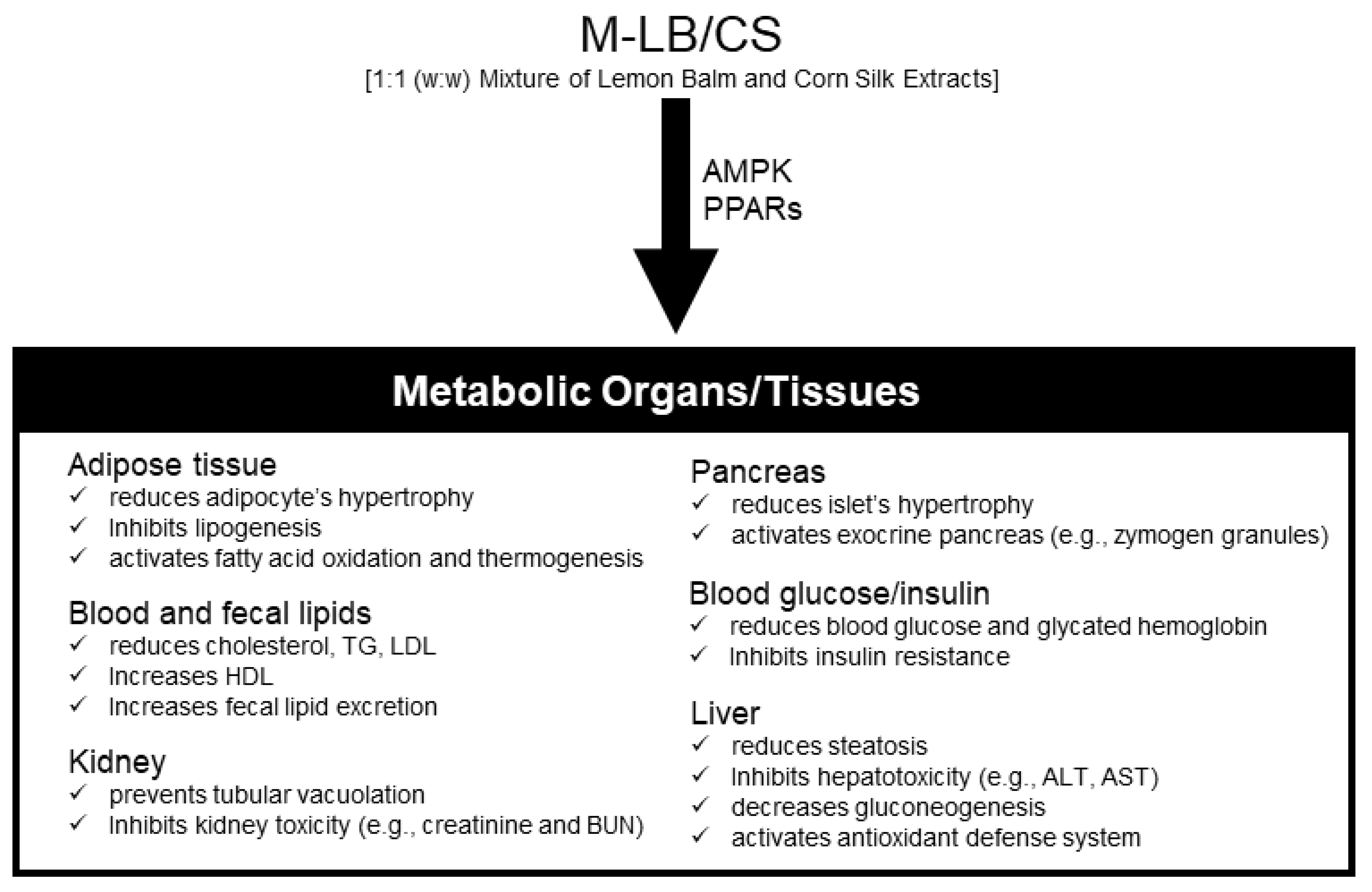Lemon Balm and Corn Silk Mixture Alleviates Metabolic Disorders Caused by a High-Fat Diet
Abstract
:1. Introduction
2. Materials and Methods
2.1. Measurement of Flavonoid Content in M-LB/CS
2.2. Quantification of Rosmarinic Acid and Allantoin in M-LB/CS
2.3. Animal Model and Treatment
2.4. Measurement of Body Weight and Relative Organ Weight
2.5. Measurement of Food Consumption
2.6. Measurement of Body Fat Mass Density
2.7. Histopathology
2.8. Quantitative Polymerase Chain Reaction (qPCR)
2.9. Measurement of Blood and Fecal Biomarkers
2.10. Measurement of Glucose 6-Phosphatase (G6pase) and Phosphoenolpyruvate Carboxykinase (PEPCK) Activities
2.11. Measurement of Malondialdehyde and Antioxidant Capacities
2.12. Statistical Analysis
3. Results
3.1. M-LB/CS Prevents HFD-Mediated Weight Gain
3.2. M-LB/CS Reduces HFD-Mediated Hypertrophy of Adipose Tissue
3.3. M-LB/CS Inhibits HFD-Mediated Abnormal Lipid Profiles
3.4. M-LB/CS Protects against HFD-Mediated Pancreatic Injury
3.5. M-LB/CS Prevents HFD-Mediated Hepatotoxicity by Ameliorating Lipid Accumulation and Oxidative Stress
3.6. M-LB/CS Alleviates HFD-Mediated Kidney Injury
4. Discussion
5. Conclusions
Supplementary Materials
Author Contributions
Funding
Institutional Review Board Statement
Informed Consent Statement
Data Availability Statement
Conflicts of Interest
References
- Alberti, K.G.; Eckel, R.H.; Grundy, S.M.; Zimmet, P.Z.; Cleeman, J.I.; Donato, K.A.; Fruchart, J.C.; James, W.P.; Loria, C.M.; Smith, S.C., Jr.; et al. Harmonizing the metabolic syndrome: A joint interim statement of the International Diabetes Federation Task Force on Epidemiology and Prevention; National Heart, Lung, and Blood Institute; American Heart Association; World Heart Federation; International Atherosclerosis Society; and International Association for the Study of Obesity. Circulation 2009, 120, 1640–1645. [Google Scholar] [CrossRef] [PubMed] [Green Version]
- Belete, R.; Ataro, Z.; Abdu, A.; Sheleme, M. Global prevalence of metabolic syndrome among patients with type I diabetes mellitus: A systematic review and meta-analysis. Diabetol. Metab. Syndr. 2021, 13, 25. [Google Scholar] [CrossRef]
- Furukawa, S.; Fujita, T.; Shimabukuro, M.; Iwaki, M.; Yamada, Y.; Nakajima, Y.; Nakayama, O.; Makishima, M.; Matsuda, M.; Shimomura, I. Increased oxidative stress in obesity and its impact on metabolic syndrome. J. Clin. Invest. 2004, 114, 1752–1761. [Google Scholar] [CrossRef] [PubMed]
- Maurizi, G.; Della Guardia, L.; Maurizi, A.; Poloni, A. Adipocytes properties and crosstalk with immune system in obesity-related inflammation. J. Cell. Physiol. 2018, 233, 88–97. [Google Scholar] [CrossRef] [PubMed]
- Cani, P.D.; Amar, J.; Iglesias, M.A.; Poggi, M.; Knauf, C.; Bastelica, D.; Neyrinck, A.M.; Fava, F.; Tuohy, K.M.; Chabo, C.; et al. Metabolic endotoxemia initiates obesity and insulin resistance. Diabetes 2007, 56, 1761–1772. [Google Scholar] [CrossRef] [Green Version]
- Tan, B.L.; Norhaizan, M.E. Effect of High-Fat Diets on Oxidative Stress, Cellular Inflammatory Response and Cognitive Function. Nutrients 2019, 11, 2579. [Google Scholar] [CrossRef] [Green Version]
- Shakeri, A.; Sahebkar, A.; Javadi, B. Melissa officinalis L.—A review of its traditional uses, phytochemistry and pharmacology. J. Ethnopharmacol. 2016, 188, 204–228. [Google Scholar] [CrossRef]
- Hasanudin, K.; Hashim, P.; Mustafa, S. Corn silk (Stigma maydis) in healthcare: A phytochemical and pharmacological review. Molecules 2012, 17, 9697–9715. [Google Scholar] [CrossRef] [Green Version]
- Kim, M.; Yoo, G.; Randy, A.; Son, Y.J.; Hong, C.R.; Kim, S.M.; Nho, C.W. Lemon Balm and Its Constituent, Rosmarinic Acid, Alleviate Liver Damage in an Animal Model of Nonalcoholic Steatohepatitis. Nutrients 2020, 12, 1166. [Google Scholar] [CrossRef] [Green Version]
- Asadi, A.; Shidfar, F.; Safari, M.; Hosseini, A.F.; Fallah Huseini, H.; Heidari, I.; Rajab, A. Efficacy of Melissa officinalis L. (lemon balm) extract on glycemic control and cardiovascular risk factors in individuals with type 2 diabetes: A randomized, double-blind, clinical trial. Phytother. Res. 2019, 33, 651–659. [Google Scholar] [CrossRef]
- Li, C.C.; Lee, Y.C.; Lo, H.Y.; Huang, Y.W.; Hsiang, C.Y.; Ho, T.Y. Antihypertensive Effects of Corn Silk Extract and Its Novel Bioactive Constituent in Spontaneously Hypertensive Rats: The Involvement of Angiotensin-Converting Enzyme Inhibition. Molecules 2019, 24, 1886. [Google Scholar] [CrossRef] [PubMed] [Green Version]
- Wang, K.J.; Zhao, J.L. Corn silk (Zea mays L.), a source of natural antioxidants with α-amylase, α-glucosidase, advanced glycation and diabetic nephropathy inhibitory activities. Biomed. Pharmacother. 2019, 110, 510–517. [Google Scholar] [CrossRef] [PubMed]
- Lee, E.Y.; Kim, S.L.; Kang, H.J.; Kim, M.H.; Ha, A.W.; Kim, W.K. High maysin corn silk extract reduces body weight and fat deposition in C57BL/6J mice fed high-fat diets. Nutr. Res. Pract. 2016, 10, 575–582. [Google Scholar] [CrossRef] [PubMed] [Green Version]
- Cho, I.J.; Kim, S.E.; Choi, B.R.; Park, H.R.; Park, J.E.; Hong, S.H.; Kwon, Y.S.; Oh, W.S.; Ku, S.K. Lemon Balm and Corn Silk Extracts Mitigate High-Fat Diet-Induced Obesity in Mice. Antioxidants 2021, 10, 2015. [Google Scholar] [CrossRef]
- Yerevanian, A.; Soukas, A.A. Metformin: Mechanisms in Human Obesity and Weight Loss. Curr. Obes. Rep. 2019, 8, 156–164. [Google Scholar] [CrossRef]
- Suh, J.T.; Kim, K.D.; Sohn, H.B.; Kim, S.J.; Hong, S.Y.; Kim, Y.H. Comparative Study of Antioxidant Activities at Different Cultivation Area and Harvest Date of the Gomchwi ‘Sammany’ Variety. Korean J. Plant. Res. 2020, 33, 245–254. [Google Scholar] [CrossRef]
- Choi, B.R.; Cho, I.J.; Jung, S.J.; Kim, J.K.; Park, S.M.; Lee, D.G.; Ku, S.K.; Park, K.M. Lemon balm and dandelion leaf extract synergistically alleviate ethanol-induced hepatotoxicity by enhancing antioxidant and anti-inflammatory activity. J. Food Biochem. 2020, 44, e13232. [Google Scholar] [CrossRef]
- Kim, C.M.; Yi, S.J.; Cho, I.J.; Ku, S.K. Red-koji fermented red ginseng ameliorates high fat diet-induced metabolic disorders in mice. Nutrients 2013, 5, 4316–4332. [Google Scholar] [CrossRef] [Green Version]
- Schmittgen, T.D.; Livak, K.J. Analyzing real-time PCR data by the comparative C(T) method. Nat. Protoc. 2008, 3, 1101–1108. [Google Scholar] [CrossRef]
- Stio, M.; Vanni, P.; Pinzauti, G. A continuous spectrophotometric assay for the enzymatic marker glucose 6-phosphatase. Anal. Biochem. 1988, 174, 32–37. [Google Scholar] [CrossRef]
- Cha, J.H.; Kim, S.R.; Kang, H.J.; Kim, M.H.; Ha, A.W.; Kim, W.K. Corn silk extract improves cholesterol metabolism in C57BL/6J mouse fed high-fat diets. Nutr. Res. Pract. 2016, 10, 501–506. [Google Scholar] [CrossRef] [PubMed] [Green Version]
- Koska, J.; Stefan, N.; Permana, P.A.; Weyer, C.; Sonoda, M.; Bogardus, C.; Smith, S.R.; Joanisse, D.R.; Funahashi, T.; Krakoff, J.; et al. Increased fat accumulation in liver may link insulin resistance with subcutaneous abdominal adipocyte enlargement, visceral adiposity, and hypoadiponectinemia in obese individuals. Am. J. Clin. Nutr. 2008, 87, 295–302. [Google Scholar] [CrossRef] [PubMed] [Green Version]
- Heydemann, A. An Overview of Murine High Fat Diet as a Model for Type 2 Diabetes Mellitus. J. Diabetes Res. 2016, 2016, 2902351. [Google Scholar] [CrossRef] [Green Version]
- Grossman, A. An overview of pancreatic exocrine secretion. Comp. Biochem. Physiol. B. 1984, 78, 1–13. [Google Scholar] [CrossRef]
- Shirwany, N.A.; Zou, M.H. AMPK: A cellular metabolic and redox sensor. A minireview. Front. Biosci. 2014, 19, 447–474. [Google Scholar] [CrossRef] [PubMed] [Green Version]
- Herzig, S.; Shaw, R.J. AMPK: Guardian of metabolism and mitochondrial homeostasis. Nat. Rev. Mol. Cell Biol. 2018, 19, 121–135. [Google Scholar] [CrossRef] [Green Version]
- Zhang, X.; Yang, S.; Chen, J.; Su, Z. Unraveling the Regulation of Hepatic Gluconeogenesis. Front. Endocrinol. 2019, 9, 802. [Google Scholar] [CrossRef]
- Maksimović, Z.; Malenović, A.; Jancić, B.; Kovacević, N. Quantification of allantoin in various Zea mays L. hybrids by RP-HPLC with UV detection. Pharmazie 2004, 59, 524–527. [Google Scholar]
- Luo, C.; Sun, H.; Peng, J.; Gao, C.; Bao, L.; Ji, R.; Zhang, C.; Zhu, W.; Jin, Y. Rosmarinic acid exerts an antagonistic effect on nonalcoholic fatty liver disease by regulating the YAP1/TAZ-PPARγ/PGC-1α signaling pathway. Phytother. Res. 2021, 35, 1010–1022. [Google Scholar] [CrossRef]
- Nyandwi, J.B.; Ko, Y.S.; Jin, H.; Yun, S.P.; Park, S.W.; Kim, H.J. Rosmarinic Acid Exhibits a Lipid-Lowering Effect by Modulating the Expression of Reverse Cholesterol Transporters and Lipid Metabolism in High-Fat Diet-Fed Mice. Biomolecules 2021, 11, 1470. [Google Scholar] [CrossRef]
- Ma, J.; Meng, X.; Liu, Y.; Yin, C.; Zhang, T.; Wang, P.; Park, Y.K.; Jung, H.W. Effects of a rhizome aqueous extract of Dioscorea batatas and its bioactive compound, allantoin in high fat diet and streptozotocin-induced diabetic mice and the regulation of liver, pancreas and skeletal muscle dysfunction. J. Ethnopharmacol. 2020, 259, 112926. [Google Scholar] [CrossRef] [PubMed]
- Govindaraj, J.; Sorimuthu Pillai, S. Rosmarinic acid modulates the antioxidant status and protects pancreatic tissues from glucolipotoxicity mediated oxidative stress in high-fat diet: Streptozotocin-induced diabetic rats. Mol. Cell. Biochem. 2015, 404, 143–159. [Google Scholar] [CrossRef] [PubMed]
- Domitrović, R.; Potočnjak, I.; Crnčević-Orlić, Z.; Škoda, M. Nephroprotective activities of rosmarinic acid against cisplatin-induced kidney injury in mice. Food Chem. Toxicol. 2014, 66, 321–328. [Google Scholar] [CrossRef] [PubMed]
- Chung, H.H.; Lee, K.S.; Cheng, J.T. Decrease of Obesity by Allantoin via Imidazoline I 1 -Receptor Activation in High Fat Diet-Fed Mice. Evid. Based Complement. Alternat. Med. 2013, 2013, 589309. [Google Scholar] [CrossRef] [Green Version]
- Kumar, S.; Pandey, A.K. Chemistry and biological activities of flavonoids: An overview. Sci. World J. 2013, 2013, 162750. [Google Scholar] [CrossRef] [Green Version]
- Chen, H.; Nie, T.; Zhang, P.; Ma, J.; Shan, A. Hesperidin attenuates hepatic lipid accumulation in mice fed high-fat diet and oleic acid induced HepG2 via AMPK activation. Life Sci. 2022, 296, 120428. [Google Scholar] [CrossRef]
- Li, J.; Wang, T.; Liu, P.; Yang, F.; Wang, X.; Zheng, W.; Sun, W. Hesperetin ameliorates hepatic oxidative stress and inflammation via the PI3K/AKT-Nrf2-ARE pathway in oleic acid-induced HepG2 cells and a rat model of high-fat diet-induced NAFLD. Food Funct. 2021, 12, 3898–3918. [Google Scholar] [CrossRef]
- Wu, L.; Guo, T.; Deng, R.; Liu, L.; Yu, Y. Apigenin Ameliorates Insulin Resistance and Lipid Accumulation by Endoplasmic Reticulum Stress and SREBP-1c/SREBP-2 Pathway in Palmitate-Induced HepG2 Cells and High-Fat Diet-Fed Mice. J. Pharmacol. Exp. Ther. 2021, 377, 146–156. [Google Scholar] [CrossRef]
- Yang, Y.; Wu, Y.; Zou, J.; Wang, Y.H.; Xu, M.X.; Huang, W.; Yu, D.J.; Zhang, L.; Zhang, Y.Y.; Sun, X.D. Naringenin Attenuates Non-Alcoholic Fatty Liver Disease by Enhancing Energy Expenditure and Regulating Autophagy via AMPK. Front. Pharmacol. 2021, 12, 687095. [Google Scholar] [CrossRef]
- Jiang, H.; Horiuchi, Y.; Hironao, K.Y.; Kitakaze, T.; Yamashita, Y.; Ashida, H. Prevention effect of quercetin and its glycosides on obesity and hyperglycemia through activating AMPKα in high-fat diet-fed ICR mice. J. Clin. Biochem. Nutr. 2020, 67, 74–83. [Google Scholar] [CrossRef]
- Lee, C.W.; Seo, J.Y.; Kim, S.L.; Lee, J.; Choi, J.W.; Park, Y.I. Corn silk maysin ameliorates obesity in vitro and in vivo via suppression of lipogenesis, differentiation, and function of adipocytes. Biomed. Pharmacother. 2017, 93, 267–275. [Google Scholar] [CrossRef] [PubMed]
- Xu, N.; Zhang, L.; Dong, J.; Zhang, X.; Chen, Y.G.; Bao, B.; Liu, J. Low-dose diet supplement of a natural flavonoid, luteolin, ameliorates diet-induced obesity and insulin resistance in mice. Mol. Nutr. Food Res. 2014, 58, 1258–1268. [Google Scholar] [CrossRef] [PubMed]
- Pu, P.; Gao, D.M.; Mohamed, S.; Chen, J.; Zhang, J.; Zhou, X.Y.; Zhou, N.J.; Xie, J.; Jiang, H. Naringin ameliorates metabolic syndrome by activating AMP-activated protein kinase in mice fed a high-fat diet. Arch. Biochem. Biophys. 2012, 518, 61–70. [Google Scholar] [CrossRef] [PubMed]
- Rosen, E.D.; Hsu, C.H.; Wang, X.; Sakai, S.; Freeman, M.W.; Gonzalez, F.J.; Spiegelman, B.M. C/EBPalpha induces adipogenesis through PPARgamma: A unified pathway. Genes Dev. 2002, 16, 22–26. [Google Scholar] [CrossRef] [Green Version]
- Hong, F.; Pan, S.; Guo, Y.; Xu, P.; Zhai, Y. PPARs as Nuclear Receptors for Nutrient and Energy Metabolism. Molecules 2019, 24, 2545. [Google Scholar] [CrossRef] [Green Version]
- Ahmadian, M.; Suh, J.M.; Hah, N.; Liddle, C.; Atkins, A.R.; Downes, M.; Evans, R.M. PPARγ signaling and metabolism: The good, the bad and the future. Nat. Med. 2013, 19, 557–566. [Google Scholar] [CrossRef] [Green Version]
- Weidner, C.; Wowro, S.J.; Freiwald, A.; Kodelja, V.; Abdel-Aziz, H.; Kelber, O.; Sauer, S. Lemon balm extract causes potent antihyperglycemic and antihyperlipidemic effects in insulin-resistant obese mice. Mol. Nutr. Food Res. 2014, 58, 903–907. [Google Scholar] [CrossRef]
- Wali, J.A.; Jarzebska, N.; Raubenheimer, D.; Simpson, S.J.; Rodionov, R.N.; O’Sullivan, J.F. Cardio-Metabolic Effects of High-Fat Diets and Their Underlying Mechanisms-A Narrative Review. Nutrients 2020, 12, 1505. [Google Scholar] [CrossRef]
- Larsen, M.L.; Hørder, M.; Mogensen, E.F. Effect of long-term monitoring of glycosylated hemoglobin levels in insulin-dependent diabetes mellitus. N. Engl. J. Med. 1990, 323, 1021–1025. [Google Scholar] [CrossRef]
- Danino, H.; Ben-Dror, K.; Birk, R. Exocrine pancreas ER stress is differentially induced by different fatty acids. Exp. Cell Res. 2015, 339, 397–406. [Google Scholar] [CrossRef]
- Li, Y.; Xu, S.; Mihaylova, M.M.; Zheng, B.; Hou, X.; Jiang, B.; Park, O.; Luo, Z.; Lefai, E.; Shyy, J.Y.; et al. AMPK phosphorylates and inhibits SREBP activity to attenuate hepatic steatosis and atherosclerosis in diet-induced insulin-resistant mice. Cell Metab. 2011, 13, 376–388. [Google Scholar] [CrossRef] [PubMed] [Green Version]
- Carling, D.; Zammit, V.A.; Hardie, D.G. A common bicyclic protein kinase cascade inactivates the regulatory enzymes of fatty acid and cholesterol biosynthesis. FEBS Lett. 1987, 223, 217–222. [Google Scholar] [CrossRef] [Green Version]
- Mihaylova, M.M.; Vasquez, D.S.; Ravnskjaer, K.; Denechaud, P.D.; Yu, R.T.; Alvarez, J.G.; Downes, M.; Evans, R.M.; Montminy, M.; Shaw, R.J. Class IIa histone deacetylases are hormone-activated regulators of FOXO and mammalian glucose homeostasis. Cell 2011, 145, 607–621. [Google Scholar] [CrossRef] [PubMed] [Green Version]
- Lee, J.M.; Seo, W.Y.; Song, K.H.; Chanda, D.; Kim, Y.D.; Kim, D.K.; Lee, M.W.; Ryu, D.; Kim, Y.H.; Noh, J.R.; et al. AMPK-dependent repression of hepatic gluconeogenesis via disruption of CREB.CRTC2 complex by orphan nuclear receptor small heterodimer partner. J. Biol. Chem. 2010, 285, 32182–32191. [Google Scholar] [CrossRef] [Green Version]
- Verhoeven, A.J.; Woods, A.; Brennan, C.H.; Hawley, S.A.; Hardie, D.G.; Scott, J.; Beri, R.K.; Carling, D. The AMP-activated protein kinase gene is highly expressed in rat skeletal muscle. Alternative splicing and tissue distribution of the mRNA. Eur. J. Biochem. 1995, 228, 236–243. [Google Scholar] [CrossRef]
- Kobayashi, M.; Yamamoto, M. Nrf2-Keap1 regulation of cellular defense mechanisms against electrophiles and reactive oxygen species. Adv. Enzyme Regul. 2006, 46, 113–140. [Google Scholar] [CrossRef]
- Joo, M.S.; Kim, W.D.; Lee, K.Y.; Kim, J.H.; Koo, J.H.; Kim, S.G. AMPK Facilitates Nuclear Accumulation of Nrf2 by Phosphorylating at Serine 550. Mol. Cell. Biol. 2016, 36, 1931–1942. [Google Scholar] [CrossRef] [Green Version]







| Gene Name | Sense Primer | Antisense Primer | ReqSeq No. | Amplicon Size (bp) |
|---|---|---|---|---|
| ACC1 | 5′-GCCATTGGTATTGGGGCTTAC-3′ | 5′-CCCGACCAAGGACTTTGTTG-3′ | NM_133360.2 | 112 |
| Adiponectin | 5′-CCCAAGGGAACTTGTGCAGGTTGGATG-3′ | 5′-GTTGGTATCATGGTAGAGAAGAAAGCC-3′ | NM_009605.5 | 639 |
| AMPKα1 | 5′-AAGCCGACCCAATGACATCA-3′ | 5′-CTTCCTTCGTACACGCAAAT-3′ | NM_001013367.3 | 103 |
| C/EBPα | 5′-TGGACAAGAACAGCAACGAGTAC-3′ | 5′-CGGTCATTGTCACTGGTCAACT-3′ | NM_001287514.1 | 136 |
| FAS | 5′-GCTGCGGAAACTTCAGGAAAT-3′ | 5′-AGAGACGTGTCACTCCTGGACTT-3′ | NM_007988.3 | 84 |
| GAPDH | 5′-CATCTTCCAGGAGCGAGACC-3′ | 5′-TCCACCACCCTGTTGCTGTA-3′ | NM_001289726.1 | 753 |
| Leptin | 5′-CCAAAACCCTCATCAAGACC-3′ | 5′-GTCCAACTGTTGAAGAATGTCCC-3′ | NM_008493.3 | 394 |
| PPARα | 5′-ATGCCAGTACTGCCGTTTTC-3′ | 5′-GGCCTTGACCTTGTTCATGT-3′ | NM_011144.6 | 220 |
| PPARγ | 5′-AGTGGAGACCGCCCAGG-3′ | 5′-GCAGCAGGTTGTCTTGGATGT-3′ | NM_00127330.2 | 64 |
| SREBP-1c | 5′-AGCCTGGCCATCTGTGAGAA-3′ | 5′-CAGACTGGTACGGGCCACAA-3′ | NM_011480.4 | 132 |
| UCP2 | 5′-CCGCATTGGCCTCTACGACTCT-3′ | 5′-CCCCGAAGGCAGAAGTGAAGTG-3′ | NM_011671.5 | 386 |
| Sample | Biomarker (Unit) | Experimental Group | |||||
|---|---|---|---|---|---|---|---|
| NFD | HFD | HFD + Met | HFD + M-LB/CS (200 mg/kg) | HFD + M-LB/CS (100 mg/kg) | HFD + M-LB/CS (50 mg/kg) | ||
| Serum | Cholesterol (mg/dL) | 87.63 ± 15.02 | 280.50 ± 23.81 a | 165.63 ± 18.72 a,c | 117.75 ± 22.34 c,e | 166.00 ± 20.15 a,c | 203.13 ± 19.97 a,c,e |
| Triglycerides (mg/dL) | 71.00 ± 15.94 | 238.25 ± 17.53 a | 138.50 ± 17.97 a,c | 106.50 ± 13.14 a,c,f | 134.25 ± 20.43 a,c | 184.75 ± 28.45 a,c | |
| LDL (mg/dL) | 16.13 ± 2.80 | 69.75 ± 12.43 a | 39.75 ± 11.49 a,c | 28.00 ± 11.55 c | 36.75 ± 10.78 a,c | 51.00 ± 10.57 a,d | |
| HDL (mg/dL) | 88.88 ± 15.68 | 22.25 ± 4.46 a | 55.88 ± 11.22 a,c | 70.38 ± 11.54 b,c | 53.38 ± 10.84 a,c | 42.63 ± 11.55 a,d | |
| Insulin (mg/mL) | 0.62 ± 0.12 | 2.51 ± 0.43 a | 1.49 ± 0.15 a,c | 1.18 ± 0.36 b,c | 1.48 ± 0.11 a,c | 1.77 ± 0.19 a,d | |
| ALT (IU/L) | 38.13 ± 12.37 | 161.38 ± 17.70 a | 104.38 ± 20.60 a,c | 66.63 ± 21.00 b,c,f | 105.50 ± 15.80 a,c | 125.75 ± 16.56 a,c | |
| AST (IU/L) | 74.50 ± 15.82 | 221.88 ± 24.52 a | 142.63 ± 15.96 a,c | 94.63 ± 11.94 c,f | 139.00 ± 8.00 a,c | 166.50 ± 16.33 a,c | |
| Creatinine (mg/dL) | 0.54 ± 0.17 | 2.10 ± 0.28 a | 1.05 ± 0.27 a,c | 0.78 ± 0.17 c | 1.03 ± 0.21 a,c | 1.43 ± 0.20 a,c,f | |
| BUN (mg/dL) | 28.88 ± 11.12 | 104.38 ± 15.77 a | 52.50 ± 16.30 b,c | 41.00 ± 13.77 c | 52.75 ± 9.48 b,c | 75.88 ± 12.47 a,c,f | |
| Plasma | Glucose (mg/dL) | 94.63 ± 23.40 | 257.13 ± 31.82 a | 157.13 ± 22.43 a,c | 129.13 ± 24.23 b,c | 153.50 ± 17.76 a,c | 186.00 ± 14.00 a,c |
| Blood | Glycosylated hemoglobin (%) | 2.94 ± 1.21 | 9.12 ± 0.80 a | 5.36 ± 0.72 a,c | 3.77 ± 1.00 c,f | 5.32 ± 0.64 a,c | 6.71 ± 1.50 a,c |
| Feces | Cholesterol (mg/g feces) | 1.20 ± 0.30 | 1.36 ± 0.27 | 3.29 ± 0.48 a,c | 4.86 ± 1.25 a,c | 3.39 ± 0.49 a,c | 2.08 ± 0.63 f |
| Triglycerides (mg/g feces) | 0.79 ± 0.14 | 0.82 ± 0.13 | 3.00 ± 1.09 a,c | 3.97 ± 0.62 a,c | 2.94 ± 0.62 a,c | 1.87 ± 0.64 b,d | |
Publisher’s Note: MDPI stays neutral with regard to jurisdictional claims in published maps and institutional affiliations. |
© 2022 by the authors. Licensee MDPI, Basel, Switzerland. This article is an open access article distributed under the terms and conditions of the Creative Commons Attribution (CC BY) license (https://creativecommons.org/licenses/by/4.0/).
Share and Cite
Cho, I.-J.; Shin, J.-H.; Choi, B.-R.; Park, H.-R.; Park, J.-E.; Hong, S.-H.; Kwon, Y.-S.; Oh, W.-S.; Ku, S.-K. Lemon Balm and Corn Silk Mixture Alleviates Metabolic Disorders Caused by a High-Fat Diet. Antioxidants 2022, 11, 730. https://doi.org/10.3390/antiox11040730
Cho I-J, Shin J-H, Choi B-R, Park H-R, Park J-E, Hong S-H, Kwon Y-S, Oh W-S, Ku S-K. Lemon Balm and Corn Silk Mixture Alleviates Metabolic Disorders Caused by a High-Fat Diet. Antioxidants. 2022; 11(4):730. https://doi.org/10.3390/antiox11040730
Chicago/Turabian StyleCho, Il-Je, Joung-Hoon Shin, Beom-Rak Choi, Hye-Rim Park, Jeong-Eun Park, Seong-Hwa Hong, Young-Sam Kwon, Won-Seok Oh, and Sae-Kwang Ku. 2022. "Lemon Balm and Corn Silk Mixture Alleviates Metabolic Disorders Caused by a High-Fat Diet" Antioxidants 11, no. 4: 730. https://doi.org/10.3390/antiox11040730
APA StyleCho, I.-J., Shin, J.-H., Choi, B.-R., Park, H.-R., Park, J.-E., Hong, S.-H., Kwon, Y.-S., Oh, W.-S., & Ku, S.-K. (2022). Lemon Balm and Corn Silk Mixture Alleviates Metabolic Disorders Caused by a High-Fat Diet. Antioxidants, 11(4), 730. https://doi.org/10.3390/antiox11040730







